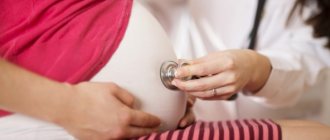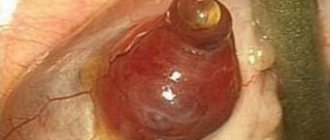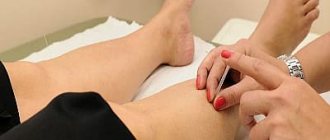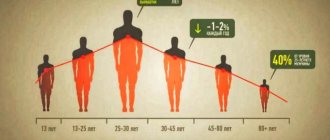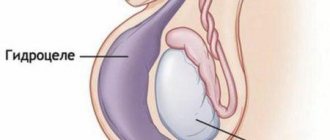Causes of infertile marriages
Infertility in women can occur for several reasons:
- Hormonal (endocrine): associated with a disruption in the production of sex hormones on certain days of the menstrual cycle, as a result of which there is no ovulation, preparation of the endometrium of the uterus for the attachment of the fertilized egg.
- Adhesions after suffering from inflammation of the pelvic organs. Gynecological history of salpingitis, adnexitis, endometriosis, surgery, trauma to the pelvic and abdominal organs, including abortion.
- Immunological incompatibility: the genesis of this type of infertility is unclear.
- Malformations of the genital organs: abnormal position of the uterus, bicornuate uterus.
The cause of male infertility is various pathological conditions affecting not only the reproductive system, but also other systems of the body. After diagnosis, the following causes are usually identified: impotence, inflammatory diseases of the genital organs (urethritis, prostatitis, adenoma), hormonal imbalance, sexually transmitted infections, psychological factors. Comprehensive treatment, where physiotherapy plays an important role, leads to good results in the treatment of both partners.
How is physiotherapy beneficial?
It is commonplace for everyone that physiotherapy is used during the treatment of joints or colds. But it is difficult to say how useful physiotherapy is in other areas of medicine, including gynecology. Not only does it help during treatment, but there are also cases in which physical therapy is the only treatment option when antibiotics and other medications do not help at all.
Physiotherapy significantly shortens the recovery period. In addition, it has no side effects, unlike chemotherapy or medications.
Physiotherapy significantly improves blood circulation in organs, normalizes their functioning and helps to completely eliminate the problem, which greatly increases the chances that the problem will not arise again.
https://youtu.be/qDC-Bgji_tA
Physiotherapy methods in the treatment of infertility
In addition to medicinal methods, physiotherapeutic methods of treatment are used in gynecology, andrology and urology. Highlight:
- Electrotherapy: galvanization method and electrophoresis, including the use of drugs.
- Light therapy (phototherapy).
- Ultrasonic method.
- Magnetotherapy.
- Mud therapy.
The use of current in the treatment of infertility
Electrotherapy includes the galvanization method and medicinal electrophoresis. The action of direct current relieves vascular spasm, improves blood circulation and metabolic processes, enhances repair, and has a resorption effect. The introduction of drugs using electrophoresis enhances its effect.
Galvanization of the upper cervical sympathetic nodes is used for treatment. For hyperestrogenism, zinc electrophoresis is recommended, and for hypoestrogenism, copper electrophoresis is recommended. The infantile (underdeveloped) uterus is favorably affected by calcium electrophoresis in the pelvic organs. Inflammation of the uterus and appendages in the chronic stage decreases with sodium thiosulfate electrophoresis. Ovarian function is normalized by the use of chymotrypsin, zinc and copper. Electrophoresis of iodine and lidase solutions effectively combats adhesions.
For male infertility, electrophoresis of vitamins, enzymes and microelements is used. Local action leads to improved blood circulation, reduction of inflammation, and disappearance of dysuric disorders. Sperm motility increases and erectile function improves.
Ultrasound therapy
Ultrasound is another method of physical treatment used in the treatment of infertility. It is based on the spread of energy in a heterogeneous environment, performing a “micro-massage” of tissues. Ultrasound has a pronounced anti-inflammatory, analgesic and vasodilator effect. It relieves vascular spasm and nervous excitability. Under its influence, regeneration is accelerated, adhesions and scar processes are reduced.
In gynecology, ultrasound (ultraphonophoresis) with hydrocortisone is used on the lower abdomen and paravertebral region of the lumbosacral spine during the subacute stage of the pelvic inflammatory process. In men, a combination of ultrasound and medications, including mud, is used in the treatment of chronic prostatitis.
Magnetotherapy
Physiotherapists recommend using the magnetic therapy method. In this case, the body is affected by an alternating or constant magnetic field. Under its influence, the functioning of the circulatory and nervous systems improves.
High-intensity pulsed magnetic therapy on the area of the appendages and uterus increases the activity of hormones and normalizes the functioning of the ovaries.
It also has an anti-inflammatory effect, relieves swelling, promotes venous outflow, thereby reducing the pain experienced by women during the menstrual and ovulatory periods. The use of a magnetic field with drug therapy in men reduces inflammation, including infectious etiology, increases vascular tone and hormone production.
Phototherapy
In the treatment of gynecological diseases leading to infertility, ultraviolet and infrared radiation are used. The mechanism of action of phototherapy is based on the use of light rays of different lengths. Under their influence, the amount of pathogenic microflora in the pathological focus decreases, which is used in the treatment of inflammatory processes of the internal and external genital organs.
Infrared laser therapy improves microcirculation and has an anti-inflammatory effect. In women with chronic inflammation of the genital organs and neuralgia of the pelvic nerves, pain is reduced. In the postoperative period, tissue regeneration is accelerated and the appearance of adhesions is prevented.
Physiotherapy in obstetrics and gynecology
Physiotherapy can be used both during pregnancy and after childbirth. In both cases, physical therapy is only beneficial.
During pregnancy, early toxicosis is eliminated with the help of physiotherapy, and the risk of miscarriage is reduced. After pregnancy, physical therapy is prescribed for women who may have inflammation of the uterine mucosa. It promotes faster healing of sutures.
Magnetic therapy is a physiotherapeutic treatment method that is often prescribed for inflammation of both the external and internal genitalia.
During magnetic therapy, the body is exposed to a magnetic field, which, due to the fact that it is created artificially, is completely controllable by doctors and can be different, which allows it to adapt to the woman’s body. That is, the magnetic field can be constant or temporary (impulsive), high or low frequency. This therapy makes it possible to eliminate irritation, in addition, it acts as a painkiller and promotes blood flow.
Physiotherapy in gynecology plays a huge role in infertility, primarily helping with adhesions of the fallopian tubes, which is most often the cause of infertility. It promotes blood flow to the pelvic organs.
After treatment for infertility with physiotherapy, an improvement in the functioning of the ovaries and the birth of a small miracle are expected. The advantage is that in the future it prevents the formation of adhesions in the fallopian tubes.
Contraindications to physiotherapeutic methods
Physiotherapy for infertility, including before IVF (in vitro fertilization), is recommended by gynecologists and andrologists. Treatment must be selected individually. It is imperative to consult a doctor to determine the duration and number of procedures. There are a number of general contraindications for prescribing physiotherapy:
- Diseases of the cardiovascular system, the presence of an artificial pacemaker.
- Severe cachexia (exhaustion).
- Blood clotting disorder.
- Epilepsy and severe mental illness.
- Oncology.
- Inflammatory pathologies in the acute stage.
- Thyroid diseases.
- Pregnancy and lactation.
- Individual intolerance to any of the methods.
The use of some methods is possible not only in a medical institution, but also at home. In this case, it is necessary to have special equipment and a preliminary consultation with a physiotherapist to draw up a detailed treatment regimen.
Physical methods of influencing the reproductive organs in women have a number of advantages. They are painless, non-invasive and absolutely non-toxic. Physiotherapeutic treatment methods have the ability to:
- activate regeneration processes;
- suppress the growth of scar tissue during the productive phase of inflammation;
- improve local immunity;
- strengthen the walls of microcirculatory vessels.
Physiotherapy is used in cases where medication is contraindicated or does not provide sufficient effect. Thus, some pathologies of the uterus and its appendages are associated with insufficient vascularization of these organs. Physiotherapy treatment, which achieves blood flow to the target organ, helps solve the problem of poor blood supply.
Ultrasound treatment
Ultrasound is used in gynecology in two versions: using laser irradiation of the groin area and using a vaginal ultrasound wave emitter. This technique is indispensable for restoring damaged endometrium (chronic endometritis) and such pathologies as:
- chronic inflammatory processes in the fallopian tubes (ultrasound with hydrocortisone);
- endocervicitis, cervical erosion;
- menstrual irregularities;
- infertility;
- infectious diseases of the external genitalia;
- atrophic changes after surgery, labor.
Physiotherapy for infertility in women using ultrasound combines the effects of heat and tissue micromassage, which leads to stimulation of blood circulation in the pelvis. Ultrasound helps to resolve adhesions, reduce inflammation, regenerate affected cells, and stimulates the hormonal activity of the ovaries. Procedures are carried out using ultrasound devices “Gineton”, “Arsa”, etc.
The therapeutic effect in the treatment of female infertility increases if exposure to ultrasound is combined with mud therapy, hydrogen sulfide baths, climatotherapy (sea, mountain), and phototherapy.
Physiotherapy in gynecology for infertility
Physiotherapeutic treatment is selected individually for each patient. The choice of a particular treatment method is influenced by the presence of contraindications, medical history, and individual intolerance to a certain type of effect.
Let's look at the main forms of infertility and find out how effective physiotherapy can be in each specific case.
Pathology of the uterus
- inflammatory diseases of the uterus (endometritis);
- pathological changes in the endometrium (polyposis, dysplasia, hyperplasia, hypoplasia, aplasia, malignant neoplasms);
- pathological changes in the myometrium (fibroids, malignant neoplasms);
- anomalies in the structure and development of the uterus (bicornuate uterus, infantile uterus, etc.);
- scar changes (after cesarean section, as a result of a chronic inflammatory process, consequences of abortions and curettage);
- endometriosis (occurs due to hormonal imbalance in the body);
- the presence of adhesions (as a result of chronic inflammation, after abortion or endometrial curettage).
Tubal-peritoneal factor of infertility
- stenotic changes in the fallopian tubes (for example, with swelling of the tube tissue due to inflammation);
- the presence of adhesions in the cavity of the fallopian tubes or pelvic organs (as a result of chronic inflammatory diseases, especially often adhesions are observed with chlamydia);
- abnormalities in the development of the fallopian tubes (absence of fimbriae).
Cervical factor infertility
- immunological infertility;
- presence of scars in the cervix area;
- adhesions in the area of the cervical canal, internal and external pharynx;
- stenotic changes in the cervical canal;
- violation of the biochemical composition and properties of cervical mucus.
Ovarian pathologies
- single ovarian cysts;
- oophoritis of various origins;
- ovarian neoplasms;
- polycystic ovary syndrome;
- depletion of follicular reserve;
- developmental anomalies: hypoplasia, etc.
It is most effective to carry out physiotherapy in the treatment of inflammatory diseases of the uterus, ovaries, and fallopian tubes. Many physiotherapy procedures have a pronounced anti-edematous effect and, to some extent, an anti-inflammatory effect. They improve blood circulation in the area of application of their action, due to which not only the local blood flow to the organ increases, but also the drainage system works better (venous and lymphatic outflow improves).
Physiotherapy can be used as a set of procedures during the rehabilitation period after surgery. Invasive fertility treatments, such as excision of cysts, fibroids, adhesions, and scars, may result in the formation of new scars or adhesions. By improving blood circulation in the area of postoperative wounds, regeneration processes are accelerated, and wound healing mainly occurs by primary intention.
Physiotherapy is also used in cases where the underlying cause of infertility is caused by a lack of local blood supply. This happens with atrophic and hypoplastic changes in the endometrium. Physiotherapy for infertility is used in combination with medications.
Physiotherapeutic treatment in gynecology
PHYSIOTHERAPY IN GYNECOLOGY
Physiotherapy (the use of physical, natural factors in medicine) is an important
component in the prevention and treatment of obstetric and gynecological pathologies
. It can be the main or auxiliary method in a complex of treatment measures, which includes operations, drug therapy, etc.
Physiotherapy is indicated for the following conditions:
— chronic inflammatory processes; — rehabilitation treatment after operations; — rehabilitation after abortions and curettage of the uterine mucosa; — preparation for pregnancy of women who have had spontaneous miscarriages and missed pregnancies in the past, preparation of the uterine lining before the IVF program; - infertility; — menstrual irregularities, algodismenorrhea; - adhesive process in the pelvic organs; - endometriosis; - pathological menopause.
Modern equipment
Caring doctors
All services in one clinic
Today, the pharmacological market offers a huge number of drugs for the treatment of gynecological diseases. However, in addition to the burden on the body and side effects
, which the vast majority of drugs have, problems of a different nature arise.
For example, with a number of chronic diseases of the female genital area, blood flow to the pelvic organs may be hampered due to changes in tissues and blood vessels.
In this case, the drug effect is ineffective, since the active substance does not reach the organ or tissue in the required volume through the bloodstream, and often has a negative effect on the woman’s body as a whole. Combination of medication with physiotherapy
,
an integrated approach to the treatment of the disease makes it possible to achieve an improvement in the condition and quality of life of a woman with a minimal drug load, since the
use of physiotherapy improves blood and lymph circulation and the intensity of metabolic processes in the affected area.
For some diseases, physiotherapy is often the only possible treatment method
.
For example, with chronic pelvic pain (a consequence of adhesions) and neuralgia of the pelvic nerves, which
exhaust patients physically and mentally and disrupt a normal lifestyle and the harmony of sexual relationships.
Physiotherapeutic treatment carried out after surgical interventions not only shortens the postoperative period, but also prevents the formation of adhesions.
This is especially important after operations to eliminate the causes of infertility. After an abortion or curettage of the uterine cavity, physiotherapy helps restore the damaged uterine mucosa (endometrium), which is very important immediately after the intervention.
Thus, there are a number of positive effects of physiotherapy:
— reduction of treatment time; - soft, painless effect; — prevention of complications and relapses; - absence of side effects typical of drug treatment; - reduction of drug load, and in some cases complete cessation of medications.
The physiotherapeutic effect is based on the fact that physical (electrical, radiation, magnetic, etc.) energy absorbed by living tissues is converted into biological reactions.
The
result of treatment depends on the specific circumstances, the number of procedures and their single dose
. The optimal effect of physiotherapy occurs during several procedures (course of treatment). If the patient receives medications simultaneously with physiotherapy, they accumulate mainly in the site of inflammation, going directly to the diseased organ.
In what cases is physiotherapy necessary?
The range of gynecological pathologies requiring a course of physiotherapy is very large.
Traditionally, this method is used in the treatment of subacute and chronic diseases of the
pelvic organs (chronic inflammation of the uterine appendages) and infertility.
With the introduction into widespread practice of operations to restore the patency of the fallopian tubes, physiotherapy has not lost its relevance as a method of postoperative rehabilitation treatment.
Physiotherapy at the first stage immediately after surgery has an anti-inflammatory effect, facilitates the course of the postoperative period and prevents the formation of adhesions. At the second stage, in the next menstrual cycle, it is desirable to carry out a full course using factors that restore the functional usefulness of the fallopian tubes.
Rehabilitation of women after abortion is also of great importance
spontaneous miscarriage or curettage of the uterine cavity due to a non-developing pregnancy.
reproductive function in the future
in different ways .
Numerous studies have shown that the vast majority of women who have undergone an induced or spontaneous abortion, menstrual irregularities and other problems in the sexual sphere do not develop immediately, but several years after the intervention. Therefore, restorative treatment aimed at the future is very important. This is more promising than a long and persistent struggle with old, advanced chronic inflammation of the genital organs and adhesions. Comprehensive programs, the main component of which is physical therapy along with drug therapy and oral contraception, are aimed at preventing infertility, menstrual dysfunction and reproductive losses in subsequent pregnancies. Recently, much attention has been paid to the treatment of uterine factors of infertility.
Inflammations of the uterine mucosa (endometritis) suffered in the past can lead to its functional inferiority.
The fertilized egg either cannot penetrate the endometrium, or the pregnancy “freezes” in the early stages of development, because There is no complete blood supply and nutrition to the developing embryo.
A spontaneous miscarriage occurs or a frozen pregnancy is diagnosed.
These conditions require subsequent curettage of the uterine cavity, which in itself is an additional trauma to the mucous membrane. After such an intervention, physiotherapy becomes an important component of the rehabilitation course. This contributes to the structural and functional restoration of the endometrium and the favorable course of subsequent pregnancies.
In recent years, so-called assisted reproductive technologies – in vitro fertilization (IVF) programs – have undergone rapid development.
The fertilized egg is transferred directly to the woman's uterus. And here the uterine factors of infertility and miscarriage (for example, chronic endometritis) become even more important, if not decisive. Therefore, physical therapy affecting the uterine mucosa is an important stage in preparing a woman for the upcoming attempt at in vitro fertilization and embryo transfer
. This is especially important for patients who have already had unsuccessful IVF attempts in the past.
Inflammatory processes
Inflammation of the uterine appendages (salpingoophoritis, adnexitis) is an insidious disease. Sometimes, passing almost unnoticed and not posing a serious threat to a woman’s life, it affects the most vulnerable - the ability to have children. According to statistics, every fifth woman who has suffered from inflammation of the appendages suffers from infertility. HOW APPENDIX INFLAMMATION OCCURS
Normally, the uterine appendages, that is, the fallopian tubes and ovaries, are sterile and free of microorganisms. But under certain conditions, for example, when intimate hygiene rules are violated, ubiquitous microbes get there and cause inflammation. These can even be the most ordinary bacteria that inhabit the vagina and at the same time always strive to expand their habitat area. In a normal state, the body resists such expansion, but if the defenses are weakened, it may not withstand the attack, especially if the composition of the microflora in the vagina does not correspond to the norm, and not very peaceful bacteria predominate in it. Another - and more likely - cause of inflammation may be sexually transmitted pathogens. Most often these are the causative agents of the so-called “hidden infections” - chlamydia, myco- and ureaplasma, as well as gonococci, trichomonas. When these bacteria enter the female genital tract as a result of infection, the acidic environment of the vagina is not suitable for them, and they tend to enter the uterine cavity and tubes, where conditions are more suitable. In addition, there is a cylindrical epithelium in which chlamydia can live. These pathogenic bacteria are armed with a sufficient arsenal of means to resist the immune system. If the analysis reveals an infection, then special treatment is required, and so does your partner.
There are some risk factors that make it easier for microbes to “get” to the uterus and appendages. These include: • any intrauterine interventions, such as the introduction of intrauterine devices, surgical termination of pregnancy; • several sexual partners; • sex without barrier methods of contraception and during menstruation;
• past inflammatory diseases of the female genital organs (there remains a possibility of persistence of the inflammatory process in case of previously undetected “latent” infections and the development of vaginal dysbiosis);
• hypothermia (the well-known expression “cold appendages” emphasizes the connection between hypothermia and decreased immunity).
The optimal effect in the treatment of adnexitis is achieved with a combination of drug therapy and physiotherapy
It is difficult to overestimate the role of physiotherapeutic procedures in the complex of treatment. Physiotherapy is one of the treatment methods that uses not chemical factors (medicines), but physical ones: pulsed currents, magnetic fields, laser, ultrasound, mud and hydrotherapy, etc. Using physiotherapeutic methods, we treat gynecological diseases such as chronic inflammatory processes appendages, adhesions in the pelvis, hormonal disorders of ovarian function, sexual infantilism, painful menstruation, cycle disorders, some forms of infertility.
Back in the middle of the last century, obstetricians-gynecologists and physiotherapists scientifically substantiated its feasibility and successfully proved in medical practice the high clinical effectiveness of physiotherapy in the acute and chronic stages of inflammation of the internal genital organs of women.
For inflammatory diseases of the female genital organs, treatment is aimed at:
• elimination of the inflammatory process and prevention of its exacerbation; • softening of adhesions (adhesions are not completely eliminated, but rather softened, stretched) and, therefore, pain relief; • prevention and elimination of changes in the activity of the nervous, cardiovascular systems, and in some cases, the gastrointestinal tract and kidneys that arise against the background of the inflammatory process; • immunomodulation; • pain relief; • detoxification; • increasing the activity of the patient's body's defense mechanisms. At all stages of treatment and rehabilitation measures and prevention, it is recommended to apply physiotherapy as early as possible and to use it consistently and actively. The optimal effect from the use of physiotherapy occurs during a course of treatment - 12-15 procedures. Physiotherapy has a cumulative effect, as a result of which positive changes continue even after its cessation.
There are contraindications to physiotherapy: malignant neoplasms, bleeding, the general serious condition of the patient, accompanied by decompensation of the main body systems.
The method of physiotherapy is selected individually depending on the stage of the disease, the presence and nature of complications, the age of the patient, and concomitant diseases.
At the First Clinical Medical Center, combined procedures are carried out, technologies and methods are used that make it possible to provide a course of treatment and rehabilitation in a short time, completely restoring health and performance. An experienced, highly qualified doctor will create an individual treatment or rehabilitation complex for each patient. And physical therapy nurses who have undergone special training will carry out all the necessary treatment and rehabilitation measures at a highly professional level. A cozy atmosphere, modern equipment, qualified personnel, an individual approach - all this will ensure the preservation of your health!
TREATMENT OF PELVIC ADHESIONS
Spikes
- these are thin or dense formations that “glue” organs together. Adhesions in the pelvis often lead to infertility and the development of chronic pelvic pain.
All human internal organs easily move relative to each other thanks to the slippery membrane covering them. The mobility of an organ is an important criterion for its good condition and ability to perform its functions.
And vice versa, any violation of mobility, fixation, “attachment” to another structure means pathology, which inevitably leads first to malfunctions in the functioning of the organ (functional disorders), and over time to changes in its tissues (structural disorders).
The formation of adhesions is a connection (soldering) of internal organs that is not provided for by nature, disrupting their normal mobility.
REASONS FOR ADHESIONS:
1. Surgical interventions.
2. Endometriosis.
3. Infections of the female genital area.
4. History of ovarian apoplexy.
These factors can also provoke the spread of infection and inflammation of the uterine appendages or injure the uterine cavity, which leads to the formation of intrauterine synechiae (adhesions).
Adhesions in the pelvis can spread in different directions, ultimately forming long chains of rigidly connected organs, tissues, and ligaments. Damage occurs according to the principle “where it is thin, it breaks,” that is, adhesive disease affects the most weakened organ located anywhere in such a chain.
TREATMENT OF ADHESIONS
At the initial consultation, the gynecologist and the patient determine the range of issues that need to be addressed. The necessary examinations (tests, ultrasound) are carried out. After the diagnosis is made, an individual plan for the treatment of adhesions is drawn up, which includes a set of therapeutic and preventive measures - physiotherapy, gynecological massage, enzyme therapy, etc.
Physiotherapeutic methods in this case include phonophoresis of therapeutic mud, electrotherapy with pulsed currents, interstitial magnetic laser electrophoresis of enzyme preparations, etc.
Make an appointment
Magnetic therapy for infertility
The following types of devices can be used for magnetic therapy for infertility:
- Impact through the anterior abdominal wall.
- Intravaginal magnetic therapy - a special device is inserted into the vaginal cavity.
Magnetotherapy helps improve the chemical composition of the blood, has an anti-edematous effect, and stimulates blood flow to the target organ. Thanks to this, the trophism of the tissues of the reproductive organs improves, as well as the regeneration processes and tissue immunity.
Magnetic therapy is effective for the treatment of chronic inflammatory processes, as well as as a course of rehabilitation after interventions on the pelvic organs. It has an anti-inflammatory effect and can be used for hypoplastic processes.
What procedures are physiological?
To treat gynecological problems, procedures such as natural, thermal, gynecological massage, and hardware are used.
Natural procedures are those based on mineral waters and healing mud. They contain a huge amount of vitamins and nutrients that have a positive effect on the body and restore damaged tissues. In almost all cases, after this treatment, there is an improvement in well-being, organ function, and a permanent cure for many female diseases.
Thermal procedures. These include paraffin treatment and ozokerite treatment, which affect the production of estrogen in the ovaries. They eliminate inflammation and help improve absorption processes in a woman’s body.
Gynecological massage is prescribed to stretch tubes, adhesions and scars that occur after inflammation. It increases hemodynamics in the genital organs, improves anabolism, eliminates problems and helps prevent inflammation in the organs in the future, normalizes menstrual function and ovarian function.
Hardware impact. At the moment, several types of hardware effects are used in gynecology, including:
- Therapy using magnetic pulses has an anti-inflammatory and analgesic effect. Most often used after surgical operations, for speedy healing of sutures and tissue restoration.
- Electrotherapy or electrophoresis helps improve blood supply to the pelvic organs and eliminates spasms of blood vessels and muscles.
- Ultrasound therapy improves the functioning of the ovaries and their production of hormones, softens adhesions, relieves pain in the ovaries and improves blood circulation.
- Phototherapy is therapy with laser and infrared rays. It has an anti-inflammatory and analgesic effect. It has a general strengthening effect on the uterus, ovaries and partly on the fallopian tubes. Used on the external genitalia and vagina.
Ultrasound treatment of infertility
Exposure to ultrasonic waves has an effect due to microvibrations of cells in the tissues of the target organ. This ensures significant blood flow to the tissues. Ultrasound:
- has a warming effect;
- improves the drainage function of the venous and lymphatic beds;
- leads to an improvement in blood composition;
- has anti-allergenic, anti-inflammatory effects.
Ultrasound treatment is effective for complex therapy of inflammatory processes in the pelvic organs.
The benefits of physical therapy
Most gynecological diseases are associated with congestion in the pelvic organs, and this greatly interferes with the elimination and treatment of other diseases, and pills alone will not be enough for treatment. But no one would like to resort to surgical intervention, and in such cases, physical therapy is prescribed.
Physiotherapy entails a number of benefits, such as:
- reduction or complete disappearance of pain in the genitals;
- complete regeneration of organ functioning;
- elimination of inflammatory processes in the body;
- improving blood supply to organs;
- more intense metabolic process after operations, difficult childbirth;
- normalizes metabolism in tissues.
Treatment of gynecological diseases with physiotherapy has many more advantages, such as:
- speedy recovery after procedures, operations and similar interventions;
- prevention of relapses and complications;
- can be combined with the use of antibiotics and other medications;
- reduces the burden on the body when using antibiotics;
- eliminates side effects after taking medications.
Laser therapy for infertility
The essence of the method is the directed action of focusing a light beam, which is capable of locally increasing the temperature of tissues. The advantages of laser therapy are the ease of implementation and painless manipulation.
Under the influence of the laser, local immunity is activated due to an increase in the number of leukocytes and immunoglobulins, and tissue metabolism processes are normalized. Laser therapy is used to treat true cervical erosions, colpitis, endometritis, and ovarian dysfunction.
Microwave therapy for infertility
In this case, electromagnetic waves of ultrahigh frequency (microwave) are used. They help strengthen vascular walls, improve blood composition, and activate the processes of restoration of subcellular structures.
Microwave therapy helps restore neuromuscular transmission, increases the number of active capillaries, and restores the body's natural biorhythms. It is effective for the treatment of benign neoplasms: polyps, ovarian cysts, fibroids, combined pathologies: fibroids and endometrial hyperplasia.
Light therapy for infertility
To treat gynecological pathology, light rays of various lengths are used: infrared and ultraviolet radiation. When treating infertility with the help of light radiation, the goal is usually to get rid of a chronic inflammatory process with a protracted course, when conventional antibacterial agents can weaken the pathogenic flora, but not destroy it. Ultraviolet rays have a detrimental effect on most pathogenic microorganisms, and also help prevent adhesions in the uterine cavity and its tubes.
Benefits of Magnetic Therapy
Magnetotherapy in gynecology is the use of a constant or pulsed magnetic field for therapeutic or prophylactic purposes. This is a natural method of influencing a woman’s body, aimed at improving blood circulation, metabolic processes in the pelvic organs, and increasing the body’s resistance after infectious diseases. The mechanism of action of magnetic therapy is based on the transformation of biologically active substances, binding of free radicals, regeneration of damaged areas at a depth of up to 5 cm.
Advantages of magnetic therapy:
- analgesic effect;
- possibility of use for many gynecological diseases;
- painlessness;
- elimination of edema;
- reduction of lymph nodes;
- accessibility and ease of use;
- the possibility of treatment during menstruation;
- activation of blood circulation in the pelvic organs;
- increasing the permeability of cell membranes;
- acceleration of redox reactions in the body;
- elimination of chronic inflammatory processes in the acute stage;
- enhancing the effectiveness of drug therapy;
- normalization of ovarian function;
- possibility of use at low-grade body temperature;
- restoration of psycho-emotional balance.
Ultraphonophoresis in the treatment of infertility
Ultraphonophoresis is usually used to administer drugs through the skin or vaginal mucosa. It increases the adsorption capacity of the epidermis and promotes the activation of drug components. At the same time, they retain all their properties.
The use of ultraphonophoresis allows the drug to be used locally in the lesion. Anti-inflammatory drugs and antiseptics are often administered in this way: hydrocortisone, potassium iodide, ichthyol, active components in therapeutic mud, etc.
The procedure is indicated for chronic inflammatory diseases of the reproductive organs, as well as to speed up the rehabilitation of patients who have undergone surgery on the pelvic organs. Ultraphonophoresis is especially often used to restore patients after removal of the fallopian tube, an operation performed in connection with an ectopic pregnancy.
Endocrine infertility
All processes occurring in the female genital organs are hormonally determined. That is why, when hormonal levels change and the production of sex hormones is disrupted, the reproductive system malfunctions and, as a result, infertility develops. Its main causes are the absence of ovulation and cyclic changes in the endometrium, the inability of the egg to fertilize, and the impossibility of embryo implantation. The following pathological conditions are associated with this:
- Primary hypothalamic-pituitary-ovarian dysfunctions: amenorrhea, polycystic ovary syndrome, hyperandrogenemia, hyperprolactinemia, hereditary diseases (adrenogenital syndrome, hypopituitarism, hermaphroditism, Shereshevsky-Turner syndrome, etc.).
- Secondary hypothalamic-pituitary-ovarian dysfunctions (thyroid dysfunction, anorexia nervosa, Sheehan syndrome, ovarian wasting syndrome, etc.).
A certain role in the development of infertility is played by dysfunction of the corpus luteum, which produces progesterone and disruption of the production of prostaglandins, which are responsible for the contractile activity of the fallopian tubes and implantation of the fertilized egg.
General contraindications to physiotherapeutic treatment of infertility
Contraindications to physiotherapy are divided into general and factorial. General ones are the same for any type of physical influence, and factor ones are specific to a particular type of procedure.
General contraindications include:
- cerebral atherosclerosis;
- systemic pathologies in the stage of decompensation (especially from the cardiovascular system);
- heart rhythm disturbances (atrial fibrillation and extrasystoles);
- presence of a pacemaker;
- blood diseases;
- tendency to bleeding and bleeding disorders;
- infectious processes in the acute stage;
- body temperature is more than 37.5 degrees.
When is physiotherapy prescribed?
The main indications for using the technique are:
- gynecological surgical interventions;
- abnormal development of the genital organs;
- uterine hypoplasia;
- inflammatory processes of nerves in the hip area;
- preparation for pregnancy or in vitro fertilization protocol;
- diseases of the mammary glands;
- obstruction of pipes;
- inflammatory processes in the uterus;
- lack of ovulation;
- cleaning the uterus;
- infertility;
- hormonal disbalance.
With tubal infertility, the work and structure of the appendages is disrupted. The causes of the pathology are: infectious and inflammatory processes, endometriosis, surgery on the pelvic organs. Obstruction of the tubes is most often associated with the presence of infections. Thus, chlamydia, causing inflammation, leads to the destruction of fimbriae and the formation of hydrosalpinx. Mycoplasmas, settling on the cells, attach to the sperm and slow it down. Ureaplasma penetrates the tubes with the help of sperm, causing their obliteration. Also, the causative agents of this disease have a toxic effect on the ciliated epithelium, which leads to a significant decrease in the rate of passage of the egg into the uterus. In addition, viruses lead to a decrease in the immune system.
Peritoneal infertility occurs in 39% of women suffering from pathology. The disease is caused by adhesive processes occurring in the appendages. The causes of development are surgical interventions, endometriosis, and inflammatory processes.
Any surgical procedure performed in gynecology can provoke the occurrence of adhesions. Physiotherapy in the postoperative period accelerates tissue regeneration, promotes recovery, and reduces the risk of developing undesirable consequences.
Factor contraindications to physiotherapeutic treatment of infertility
Contraindications to electrophoresis
- presence of skin damage (cracks, abrasions, scratches);
- paresthesia;
- allergy to the administered medication;
- acute purulent-inflammatory processes of any localization;
- the presence of metal objects in the affected area.
Contraindications to ultrasound and ultraphonophoresis
- the presence of weeping eczema or nevus in the area of the device;
- pathologies of the cardiovascular system;
- osteoporosis;
- acute infectious processes at the site of action;
- complication of gastrointestinal ulcer;
- bronchitis and pneumonia when allergosis manifests itself in the acute phase of inflammation;
- diseases associated with the formation of stones (cholelithiasis and urolithiasis).
Why is it worth undergoing physiotherapeutic treatment at the Clinic of Innovative Technologies?
- We provide comprehensive treatment: we select not only physiotherapeutic procedures, but also medications.
- We trust treatment to doctors with over 20 years of experience. Over the years, our gynecologists have helped hundreds of patients.
- We make appointments for gynecologist consultations and procedures online in advance so that you can come to the clinic at a convenient time and not wait in line.
To consult with a gynecologist or immediately sign up for the desired physiotherapy procedure, fill out the form on the website.
